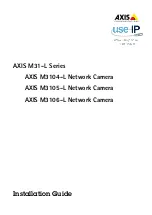
NAT:
Network Address Translation (NAT) on the WAN interface of the Logic-5000 unit.
When NAT is enabled, the LAN (Ethernet) is considered private, the WAN is considered
public. Any IP packets leaving the Logic-5000 unit through the WAN interface will have its
source IP address changed to that of the WAN interface.
Port Forwarding:
Enable - The Logic-5000 unit performs port forwarding. The "IP Mapping
Table" contains the rules used to perform port forwarding. Disable - The Logic-5000 unit
does not perform port forwarding on the WAN interface.
Mapping Number:
User selected generic number assigned for this route.
Protocol:
TCP, UDP, or both - driven by the protocol used by the third party device
Source IP Address:
Enter the IP address of the remote PC connecting to the third party
device. (This should only be done if a single PC with a STATIC IP is accessing the device and
you want to limit access to the device.) If you will be accessing the third party device from
multiple PCs, or from a PC that has a dynamically assigned WAN IP, enter 0.0.0.0 (wildcard)
to allow all remote PCs to access the third party device.
Incoming Port:
Enter the port of incoming request. This can be any non-conflicting port
(can be the same as the destination port). This value must be entered following the Logic-
5000 IP address into a browser on a remote PC to access the third party device.
Destination IP Address:
IP address of third party device; must be on the same subnet as
the Logic-5000.
Destination Port:
Enter the port of the third party device. This will be assigned to the
device by the third party manufacturer and should be in the user manual of the third party
device.
IMPORTANT NOTE:
The password protection on the Logic-5000 product does not protect logging into a third
party device. The third party device must provide its own password protection (confirm if
password protection is required).
Click Add when route configuration is complete. The route will be displayed at the bottom of
the page. Additional routes may be added but require a unique mapping number and port
number. Routes can be deleted (cleared) if no longer needed.
Once the route of the third party device is added you can enter the following on a remote
PC to access the third party device.
5.7.2.
Advanced Settings – Dynamic DNS (NO-IP Configuration)
Dynamic DNS is an option for remote monitoring if a static WAN IP address is not available
or not yet assigned. When Dynamic DNS is activated, the Logic-5000 radio modem will
register its dynamically assigned IP address with NO-IP’s application, allowing the user to
login to the device remotely without knowing the IP address of the Logic-5000 radio
modem.
Page 39 of 59
















































